Written by John Wakefield – Owner of Artistry in Glass
Double and triple-paned windows are becoming increasingly popular due to their superior insulation properties. However, the choice of window frame material is equally important. In this comprehensive guide, we will delve into the various materials used for window frames and discuss which ones are best for double and triple-paned windows.
The importance of window frames
Before we discuss window frame materials, it’s important to understand double- and triple-paned windows and why they are superior to single-pane windows in terms of energy efficiency. Jump to this section to learn about double- and triple-pane windows.
Here is the bottom line on window frame material: even though modern insulated glass is energy-efficient, a poorly designed frame can suffer substantial heat loss or gain.
So, what window frame material do we recommend?
Fiberglass & wood offer superior insulation but come at a high cost. Aluminum is strong but conducts heat, making vinyl the ideal balance of price & efficiency.
But the devil is in the details – so read on to understand more:
Properties of a window frame
An effective frame should have the following properties
Air leakage
Air leakage can occur between the window sash and the frame, This is normally made airtight by a compression seal made of rubber.
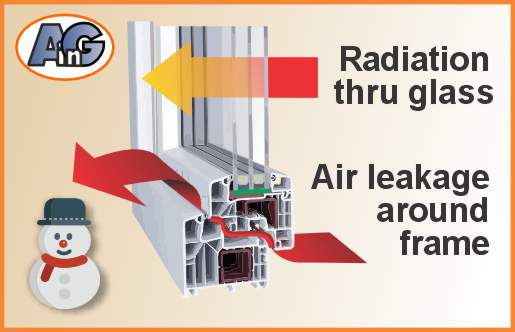
Most modern frames will have air leakage specified on the NFCS label – this should be < 0.3 to qualify as an energy-efficient window.
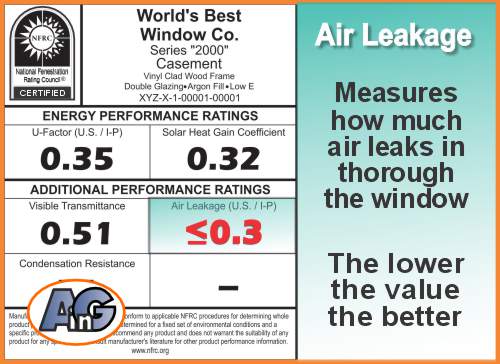
Minimize the conduction of heat
The insulation value of window frames needs to be high for energy efficiency.
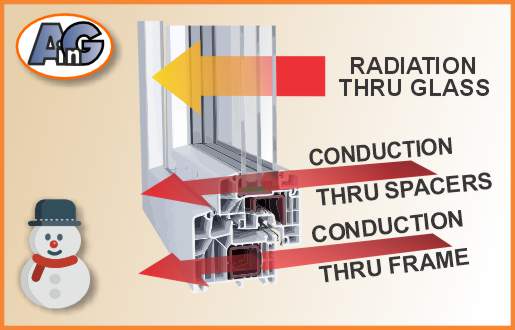
The thermal conductivity of various window frame materials is shown in the table below:
Note that windows in the 1970s and 1980s were made with aluminum frames and were a major cause of unwanted heat loss or gain.
| Material | Approx Thermal Conductivity |
|---|---|
| Aluminum | 160 |
| Fiberglass | 0.23 |
| Fibrex * | 0.22 |
| Vinyl (UPVC) | 0.17 |
| Wood | 0.12 |
| Composite | 0.12 to 0.30 |
* Fibrex® is the trade name for a composite wood/polymer material made by Andersen.
Resist water and weathering
The traditional, and most attractive choice of frame material is wood – which has a very low thermal conductivity but needs maintenance to avoid damage due to weathering and water damage. Composite frames made of wood with aluminum cladding partly solve this problem
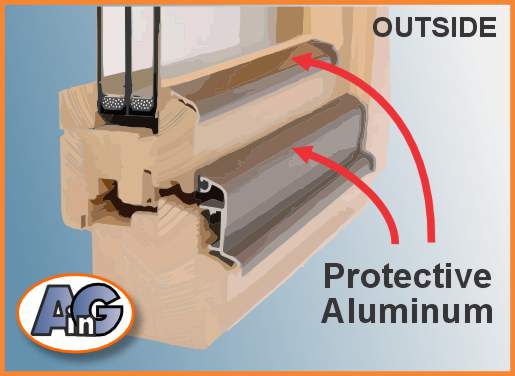
Several companies advertise treated wood that is weather-resistant, including AuraLast® pine made by JELD-WEN and available at Home Depot..
This is a patented wood product that helps provide protection against wood rot, water saturation, and termites. The water-based treatment process fortifies wood all the way to the core, providing an exclusive level of protection.
Be easy to maintain
Wood requires maintenance to prevent damage by weathering but vinyl and aluminum resist water damage. The most robust material is fiberglass but this is the most expensive.
As an Amazon Associate, I earn from qualifying purchases
Choice of material for window frames
The choice of material for the window frames plays a pivotal role in the overall performance of these windows and especially the thermal efficiency. The most common are:
- Vinyl
- Wood
- Aluminum
- Fiberglass
- Composite
I could not find current sales figures for residential window sales according to frame type. However, the commercial trends shown below (from Grand Review Research) are similar.
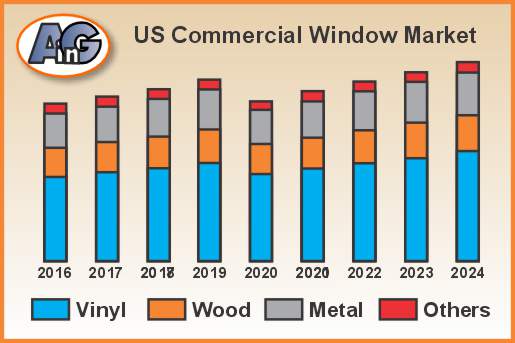
Note that vinyl still dominates the frame market with wood and aluminum being important players. “Others” include fiberglass and so-called composite materials.
Vinyl window frames
Vinyl window frames are typically made from uPVC, which stands for unplasticized polyvinyl chloride – a rigid and durable form of PVC,
Vinyl window frames are highly resistant to the elements, including moisture, rot, and insect damage. They don’t warp or corrode over time, making them a low-maintenance and long-lasting option for homeowners. This longevity translates to cost savings in the long run, as vinyl window frames typically require little more than occasional cleaning to maintain their appearance and functionality.
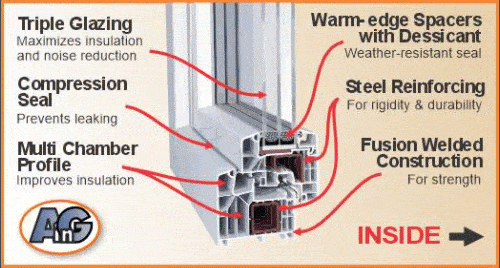
Vinyl window frames also offer excellent energy efficiency by insulating the home effectively. They prevent heat loss in winter and heat gain in summer, leading to significant savings on heating and cooling costs. Modern vinyl windows often feature multi-chambered designs and advanced weatherstripping, further enhancing their energy-saving capabilities. With their affordability, durability, and energy efficiency, vinyl window frames are a popular choice for homeowners seeking comfort and efficiency improvements. Innovations like foam filling and carbon-fiber reinforcement further enhance their performance.
Remember that a handy home-owner can install their own vinyl framed, double pane glass window and save big bucks on labor charges, Order standard sizes like this on Amazon
Wooden window frames
Wood window frames have a timeless appeal and offer natural insulation properties. They are visually appealing and can complement the aesthetics of older or traditionally designed homes. However, wood frames require regular maintenance to prevent warping, rot, and decay, which can be a drawback for some homeowners.

To enhance the energy efficiency of wood frames for double and triple-paned windows, they can be combined with other materials, such as vinyl or aluminum cladding. This provides the benefits of wood’s aesthetic appeal while improving the frame’s durability and insulation properties.
Aluminum window frames
Aluminum window frames are known for their durability and strength. They are lightweight and can be designed with a slim profile, allowing for more glass area. However, aluminum is a highly conductive material, which means it is prone to heat loss. This can result in reduced energy efficiency when used in double or triple-paned windows.
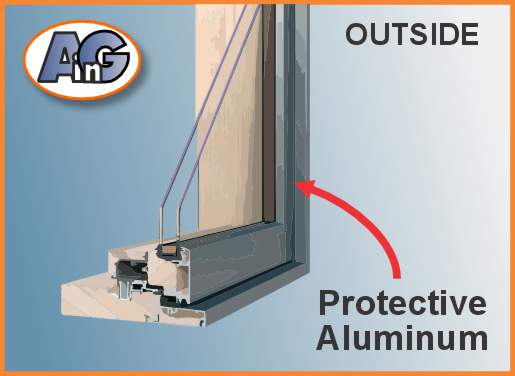
To address this issue, thermal breaks can be added to aluminum frames. These breaks are typically made of a less conductive material, such as plastic, to reduce heat transfer. While thermal breaks can improve the energy efficiency of aluminum frames, they may not match the insulation properties of some other materials.
Fiberglass window frames
Fiberglass window frames offer exceptional durability, weather resistance, and longevity. They can withstand extreme temperatures and high humidity without warping, rotting, or corroding, surpassing traditional materials like wood or aluminum. This longevity reduces the need for frequent replacements and maintenance, making them a low-maintenance and cost-effective choice for homeowners.
Furthermore, fiberglass frames excel in thermal performance, acting as effective insulators, which helps maintain a consistent indoor temperature and reduces energy consumption. This results in lower heating and cooling costs over time.
Additionally, fiberglass frames are customizable, coming in a variety of colors and finishes to enhance a home’s aesthetic appeal while delivering outstanding energy efficiency. In summary, fiberglass windows offer a combination of durability and energy savings, making them a smart choice for homeowners.
Composite window frames
The term “Composite” when describing window frames can mean either frames made of several materials – like the common combination of wood with aluminum protection, or it can mean a frame made of a “composite” material – like the mixture of wood fibers and plastic products like the Andersen material called “Fibrex”.
The use of composite materials in window frames offers a range of significant benefits, making them an increasingly popular choice for homeowners and builders. Composites typically consist of a combination of different materials, such as fiberglass, vinyl, or wood fibers, held together with a resin or adhesive. One of the primary advantages of composite window frames is their exceptional durability and resistance to weathering. Unlike traditional materials like wood, composites are highly resistant to moisture, rot, and insect damage. They maintain their structural integrity even in harsh climates and can endure exposure to UV rays, ensuring they last longer with minimal maintenance.
Energy efficiency is another notable benefit of composite window frames. Composites have excellent insulating properties, helping to reduce heat transfer and maintain a comfortable indoor temperature. This thermal efficiency can significantly lower energy bills by reducing the need for heating and cooling. Composite frames are also highly customizable, allowing homeowners to select from a variety of colors, styles, and finishes to complement their home’s design. These versatile materials combine the best features of various components to offer a practical and aesthetically pleasing solution for modern window frame construction.
Comparing the Materials
The crucial properties of the frame materials – energy efficiency, durability, water resistance, degree of required upkeep, upfront cost, and long-term value, are compared in the table below.
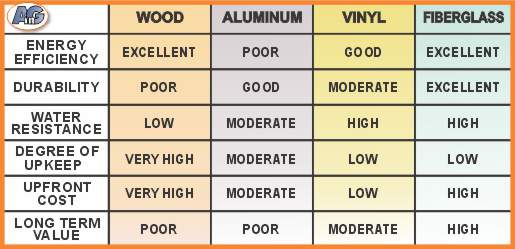
As the table indicates, the various materials all have their pros and cons – we expand on their suitability for double and triple-paned windows below:
- Thermal Performance:
- Fiberglass and composite frames provide the best thermal performance due to their non-conductive properties.
- Wood, with proper cladding, can also offer excellent insulation.
- Vinyl and aluminum frames may require additional measures like internal chambers or thermal breaks to match the thermal performance of other materials.
- Durability:
- Fiberglass, composite, and aluminum frames are known for their durability.
- Wood frames can be durable with the right maintenance.
- Vinyl frames are less durable than some other materials and may not be ideal for areas with extreme weather conditions.
- Maintenance:
- Vinyl, fiberglass, and composite frames are low-maintenance.
- Wood frames require regular maintenance to prevent issues like warping and rot.
- Aluminum frames may require occasional maintenance to prevent corrosion.
- Aesthetics:
- Wood frames offer a classic and timeless aesthetic.
- Vinyl, fiberglass, and composite frames can be designed to mimic the appearance of wood or come in various colors and styles.
- Aluminum frames often have a sleek and modern appearance.
- Cost:
- Vinyl frames are typically the most affordable.
- Aluminum frames are moderately priced.
- Fiberglass, composite, and wood frames are often in the higher price range.
Conclusion
Choosing the best material for double and triple-paned window frames depends on your specific needs and preferences. Fiberglass and composite frames are top choices for those seeking optimal thermal performance and low maintenance. Wood frames, with the right cladding, can be a beautiful and energy-efficient option for traditional or rustic homes. Vinyl frames are budget-friendly but may require additional features to match the insulation properties of other materials. Aluminum frames can be made more energy-efficient with thermal breaks, making them a viable choice for certain applications.
In the end, it’s crucial to consider your location, climate, budget, and aesthetic preferences when selecting the material for your window frames. Double and triple-paned windows, when combined with the right frame material, can significantly enhance your home’s energy efficiency and comfort, providing long-term benefits for you and your family.
Understanding Double and Triple-Paned Windows
Double-paned windows consist of two layers of glass with a space between them. This space is filled with insulating gas, typically argon or krypton, which reduces heat transfer and helps maintain a comfortable indoor temperature.
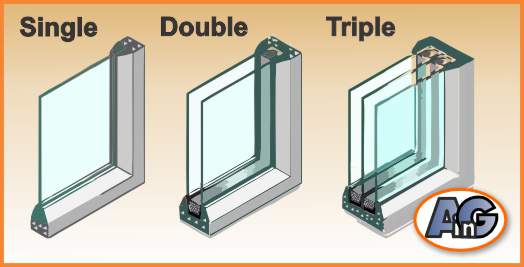
Triple-paned windows, are even more energy-efficient, having three layers of glass with two insulated spaces filled with gas.
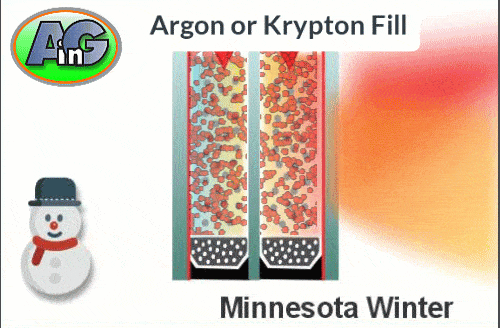
This additional layer, together with Low-E coatings greatly improves the temperature control of triple-pane windows.
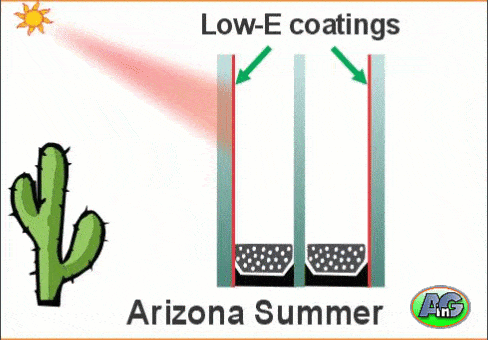
But remember – even the best insulated glass in ineffective if the frame leaks air and conducts heat.
Learn all about energy-efficient windows in these posts:
- What is Low-E Glass & how can it reduce your utility bills?
- How do argon-filled windows save on energy bills?
- Are replacement windows worth the investment?
- Understanding the Labels on Your Double-Pane Glass Windows
- Is Upgrading to Triple-Pane Windows Cost-Effective?
- The Ultimate Window Frame Material Challenge – which is best?


